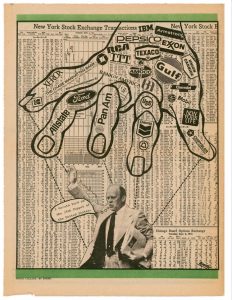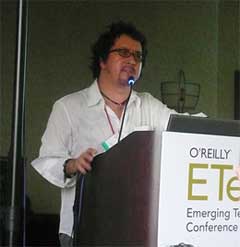 More etech08 talks with W. James Au’s take onWhy Won’t Second Life Just Go Away, Already? Understanding Web 2.0’s Most Misunderstood Phenomenon
More etech08 talks with W. James Au’s take onWhy Won’t Second Life Just Go Away, Already? Understanding Web 2.0’s Most Misunderstood Phenomenon
Throughout 2007, publications like Wired, Forbes, and the LA Times pronounced Second Life over-hyped, while negative press over Ponzi schemes, porn, etc. suggested imminent disaster. Meanwhile, the world’s user base tripled (both in terms of monthly active and maximum concurrent users), and continues attracting about a half million new sign-ups a month. How can this possibly be happening?
W. James Au is the author of the recently published The Making of Second Life (amazon usa and uk), online games editor at GigaOM.com, and lives as an embedded journalist inside Second Life on New World Notes. In his blog he takes the position of some kind of archivist conducting ethnographic research of everyday practices and life in this emerging world..
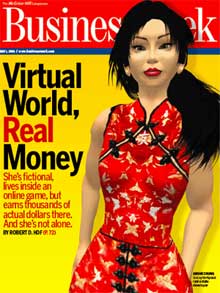
Second Life… “What was it again?” (James Au’s PPT slides)
After the year 2006 where SL was on everyone’s lips, that was the year i interviewed W. James Au. I actually never really got into SL. I found its aesthetic repulsive but i never stopped finding fascinating pieces of information about what SL was revealing about our society and how it is also contributing to its current shape in James’ New World Notes. I was probably not the only person at etech who cultivates some curiosity for the synthetic world. The room was as packed as possible and the doors were left open to allow people crammed in the corridor to listen to the talk.
In Spring 2006, SL made the cover of Business Week. It’s Anshe Chung – the “virtual Trump” – who got the cover. The avatar has built a development from nothing and quickly turned it into an operation of 17 people.
A mini dot.com boom followed as many other articles followed Business Week enthusiasm. That’s when companies started to knock on the door of Linden Lab with requests to be allowed to get in. Linden Lab resisted for a long time but they changed their policy and allowed companies to buy land like any other user.
These companies would start opening shops to display and sell their stuff to avatar. One of the first company who joined SL was American Apparel. But their efforts were quite useless as the online shops was empty most of the time, most players were just ignoring it. James draw a comparison between this empty shop and the scarcely visited homepage of McDonald’s in 1996. The pattern is similar, loads of modern is thrown to join the hype but with very little effect.
James went on by comparing shops selling cars. It appears that a kid who had opened his own shop and made it more appealing with hot babes and rap music was selling way more cars than Nissan who had just opened a shop which didn’t looked much more than a giant vending machine.
Anyway, in 2007 the backlash started to hit hard:
Second Life: It’s so popular, no one goes there any more.
The truth lies probably somewhere between the utopia described in the previous paragraphs and the disaster scenarios that would mushroom in 2007.
The first backlash arrived with a blog entry from Clay Shirky.
He was right and soon magazines such as Wired, LA Times, Forbes and many others were reporting failure of commercial ventures in SL.
A company called Yankee Group released figures that claim that user’s activity had dropped to 12 minutes per month. However the company was unable to sustain these figures when asked to do so.
While backlash stories kept coming in, the active user base has tripled in the space of a year.
TV series like CSI and The Office featured SL in one of their episodes. CSI proposed a feature where the story would continue inside SL. However neither of these TV appearances have contributed much to the overall growth of SL. It’s not the media that drives long term activities.
 Image Just Jared
Image Just Jared
SL keeps on attracting innovation and major companies continue to invest heavily in SL, not just for marketing but also for practical applications:
Interactive demo of the future Cisco Connected Health hospital campus, Palomar West due to open in San Diego, California, in 2011. Video:
IBM uses SL as a platform to design prototypes (3D data center) using OpenSimulator, OS version of SL, reverse engineering project.
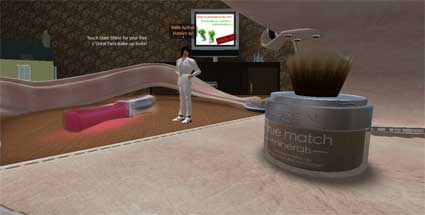 Image New World Notes
Image New World Notes
Greenies, a ’50s style crazy room filled with tiny green aliens attracted the attention of L’Oreal Paris which started to advertise there by placing Copies of their products inside the funhouse. Corporations have learned their lesson and now adjust to what users want.
Corporation presence per se is not as important as one might think. Companies own a total of 2000 islands, that’s 15% of the private-owned island which means that corporation presence on the total land mass amounts to less than 5%.
3 principles that make SL keep thriving (so far):
1. Mirrored flourishing – “What you do here should make you better out there”
This principle has been part of the community since its origins
Catherine Omega built a mansion on SL while she was homeless. She was squatting an apartment inhabited by drug addicts and somehow managed to get an internet connection in her place. SL was her portal into a better world. Because of her talent people started coming to her to help them build their house and that’s how she started to make a real income. Today she is a SL consultant for companies.
The activities you do in SL can potentially improve your own life. Disabled people who have to stay home use SL to meet other people and get a social life.
SL is a space that creates opportunities. Users own the IP right to the content they create on SL.
2. Bebop Reality – “The virtual world as a 3D jazz combo”
In SL furries coexist with hot babes, angels and robots and that’s not science-ficition. In the SL atmosphere, there are clashes and mergings of different races, species and tastes. You’ll find a space station next to a church next to a strip joint. Everyone is part of the same society.
3. Impression society – Whaddya got, and how long are you gonna stick with it?
In SL making an impression is about being cool, compelling, exciting. It is not about money but about how much creativity you can bring to the community.
Impression is also about how long you stay there and provide and that’s something that shows by the look of your avatar. A well-dressed avatar for example shows that its user cares for it, has been in the community long enough to polish the appearance of its character. Long-term activity is a prerequisite if you want to be cool in SL.
SL is a very frustrating experience at the beginning. There are neither rules nor guidelines, you have to make them up on your own. According to James Au the result is that SL is an international cutting edge creative space with high barriers to entry.
Kowloon: a Japanese studio 4 made a video game inside SL so that gamers can live inside the game. There’s actually a huge amount of content no one knows about. Some of the most active users are from Brazil and Japan.
Steampunks are an active community in SL and a rather large one with 30 to 35 000 active users.
Midian cities, role play inside SL giving its users a “third life”. Like a mini-MMO. The users don’t chat as much as they write a story collaboratively and on the fly.
Innovation
My Second Life, The video diaries of Molotov Alva: documentary in SL (coming soon to HBO). There are many Machinima makers but only ten of them can be regarded as top talent as their movies go beyond the usual audience of the SL community. Usually machinima don’t, they are for insiders.
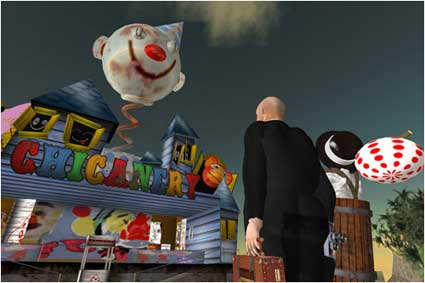 My Second Life, Screenshot
My Second Life, Screenshot
Ajax Life, a web-based client for Second Life that does not rely on browser plugins. Made and constantly improved by a 15 year old girl between her classes.
Several versions of SL on the phone.
SL hooked up with a jogging treadmill. Video:
3D architectural design and prototyping: wikitecture, 3D objects are “wikified”.
Example 4 dozen people create project of a health center in Nepal for the OAN Nepal Challenge.
James also mentioned a Danish architecture studio which uses SL to play with SL and tries to figure out what architecture could be like were it not all those regulation rules, they came up with a desing of building that looks like pearls and some Chinese contractors found about it and the building might be realized in China.
No matter if and how SL grows up it has proved itself as a valuable platform for experimentation and prototyping. 300 universities using Sl as a teaching tool.



